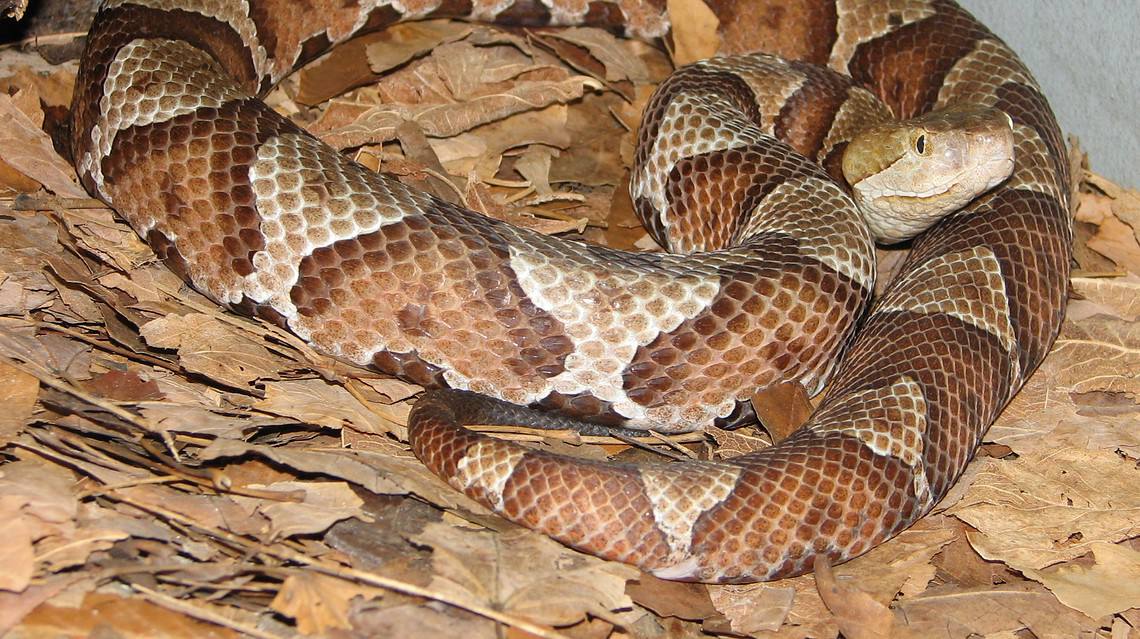Snakes At Arabia Mountain: How To Identify And What To Do If You See One

Ophidiophobia, the fear of snakes, is extremely common. Due to a large variety of snake species across the globe, it’s difficult to distinguish between venomous and nonvenomous kinds, and many people tend to regard all snakes as threatening.
A recent video of two copperheads on the PATH near the Stonecrest Public Library, one of which had its jaws locked around a cicada larva, was posted to the Arabia Mountain Heritage Area Alliance social media accounts. The video went viral, reaching over 800,000 people on Facebook. In the comments, some expressed their strong disdain for copperheads, and all snakes in general, prompting others to respond with environmental rebuttals. So to clear up some misconceptions regarding snakes and the danger, or non-danger, they pose, this Field Note will help readers identify snakes endemic to the Arabia Mountain National Heritage Area and what to do should they be encountered.
Venomous Or Not?
Body thickness, head shape or scale patterns? What is the surest way to distinguish between venomous and non-venomous species? Although it’s true that thinner snakes with longer heads tend to be nonvenomous, this isn’t a rule of thumb. The mesmerizing coral snake—recognizable by its black, yellow and red-banded coloration—is venomous yet possesses a sleek and long body with a stout head. This snake isn’t frequently seen in North Georgia, but it’s one to avoid—and it doesn’t fit the appearance of most common venomous snakes, such as rattlesnakes and other pit vipers with thicker bodies and puck-shaped heads.

The venomous eastern coral snake (Micrurus fulvius) can be found around Georgia’s Coast Plain.
There are also several lookalikes frequently mistaken for venomous species. Overall it’s best to leave snakes be, especially considering it’s illegal to kill native, nonvenomous snakes in Georgia according to Georgia Code § 27-1-28. Most snakes are non-aggressive and will leave you alone if you do the same.
Snakes In Metro Atlanta
Georgia is home to 46 different species of native snakes, and only 6 of them are venomous: the copperhead, cottonmouth, eastern diamondback rattlesnake, timber rattlesnake, pygmy rattlesnake, and eastern coral snake. However, only copperheads, timber rattlesnakes and pygmy rattlesnakes have a consistent presence throughout the Georgia Piedmont and in the Arabia Mountain National Heritage Area.

Eastern copperheads (Agkistrodon contortrix) have yellow-green tails as juveniles which act as bait, helping the copperhead attract and capture prey.
The most encountered venomous snake species in North Georgia are copperheads. A good way to identify them is the design on their backs, which features a pattern of widening stripes frequently compared to Hershey’s Kisses. They can be confused with nonvenomous corn snakes, which are brownish-orange with a slightly similar coloration pattern. Copperheads remain resilient in the face of urbanization. With Metro Atlanta’s ever-expanding sprawl, more natural areas are taken over, and human and copperhead habitats continue to overlap even more. Due to this, copperheads are out and about in DeKalb County, so be prepared for potential encounters with this snake if you frequent the heritage area.

The harmless corn snake (Pantherophis guttatus) is one of many species of snakes that is commonly confused with a venomous lookalike (in this case, the copperhead).
Timber rattlesnakes (Crotalus horridus) are typically light, yellowish or dark brown with black, zigzagging bands and, of course, have a rattle-like growth at the end of their tails as a warning not to get too close. If you hear a rattlesnake’s rattle, walk away and the snake will not pursue or engage. As their name suggests, these snakes are found in more rugged and wooded areas. As for pygmy rattlesnakes (Sistrurus miliarius), they are gray with black spots all over, and reddish spots spanning their backs; some specimens have striking red bodies. They grow to only about 12-24 inches in length when fully mature. Pygmies prefer habitats near water sources but can be found in sand hills, swamps and woodlands as well.

A beautiful example of a timber rattlesnake’s zigzagging pattern.
Snakes Don’t Want Confrontation
Many animals such as snakes, spiders and stinging or biting insects carry stereotypes that greatly exaggerate their danger and aggression. In reality, the rate of encounters with snakes that result in bites or injury is very low. Keep in mind that the snakes’ daily goal is to live another day. This can help reduce the fear created by these harmful and inaccurate stereotypes. Snakes will avoid confrontation, and will frequently even hide from humans or warn them (like the rattle snake), making their bite a last-resort defense.
If bitten by any snake, call 911 or go to the hospital immediately. Although nonvenomous snake bites do not cause much harm aside from some pain, it’s smart to take the same safety measures. There is a possibility of identification error, allergic reactions and possible infections that could be caused by the bite. Seek medical attention to reduce the likeliness of harm.

A pygmy rattlesnake coiled up in a defensive posture.
Identifying Other Snakes
Although unlikely, encounters with non-native snakes do occur, whether they are invasive or have simply traveled outside of their usual range. For instance, it’s possible for a cottonmouth, whose normal range typically excludes Metro Atlanta, to end up in our area. Because of this, it’s good to be familiar with snakes that live in surrounding areas. And it’s necessary to give all snakes the respect that you would give the venomous ones. Unreasonable fear of these creatures will get in the way of being able to enjoyably coexist with them and appreciate their presence and necessary impact on the ecosystem.
The Georgia Department of Natural Resources has an excellent resource on their website for identifying snakes around Georgia, with more information regarding their ranges, behaviors and other useful content. Most importantly, it provides detailed content about each of Georgia’s venomous snakes, like this brochure that helps identify the cottonmouth.